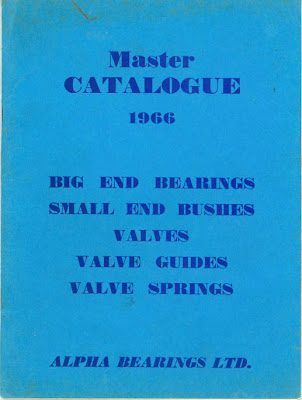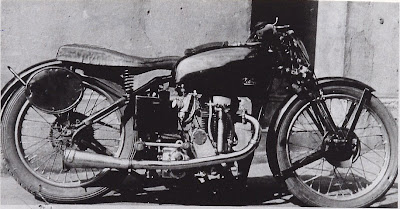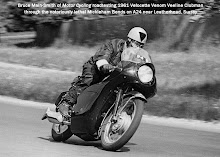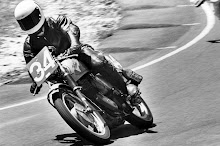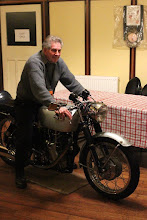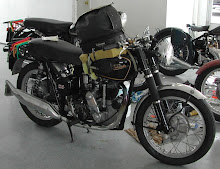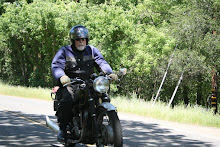Alpha Bearings Limited are a company well known in English motorcycling circles for big end assemblies....
Actually they have made other items over the years including engine valves, small end bushes, valve guides and after acquiring the Romac Cable making business, supplied speedo and tacho cables as well amongst other things.
Situated in Kingsley Road, Netherton near Dudley in the West Midlands of the UK, I remember when I first visited them on a business trip in September 1986. I'd borrowed a BMW R100/7 from a long time UK friend, Elvin Bitchell to run around the UK and Europe ( a cheapskates business trip...actually I relished the riding and camping it entailed...but that is a story for perhaps another post..) visiting various businesses of interest, predominately speedometer oriented, and so Alpha were on the list.
It was one of the "hole in the wall" type entrances and some shock when I came upon it riding slowly down Kingsley Road...
Entering the open door I advanced down a darkened passage to one of those half doors such as you find in a horse stable, the top half open..."hello in there!" ...a friendly face appeared and we introduced each other....
Enough of the preamble, I've several Alpha master catalogues I want to share data from with you, this will be Velocette oriented, but for others, the introduction side of the catalogues make interesting reading.
Perhaps I'll publish a more complete listing for other motorcycle brands at a later date...
I've one catalogue up to 1953 and the other up to 1966.
Lets look at the 1953 one first...
I acknowledge copyright to Alpha Bearings Ltd., who are still actively in business...
Left click on the images to enlarge them all for better viewing....
The 1953 catalogue cover...the books came from a now defunct Sydney Motorcycle Accessory firm, Omodies Ltd., and as you can see by the stamp on the top of the cover the Australian importer for Alpha at that time was Eustace G.Jones in Melbourne, Victoria.
Flyleaf for the 1953 catalogue....
Following are information pages from the 1953 catalogue, omitted in the 1966 edition...
The 1966 Alpha Bearing catalogue cover...
The introduction of the Alpha Tru crankshaft truing jig for 1966...
Alpha small end bush listing to 1966, covering Velocette.
Alpha small end bush codes for Velocette to 1966.
Alpha big end codes and dimensions covering Velocette to 1966.
Interesting information....
The codes....
V1..... 1932-1940 GTP
V2.....1934-1948 MOV
V3.....1934-1960 MAC and 1936-1948 KSS MK.2
V4.....1935-1948 495cc, 81 x 96 MSS
V5.....1938 Mk.7 and 1939-1950 Mk.8 KTT
V6/9..1956-1971 VENOM, VIPER and 1954-1971 86 x 86 MSS
V7......1957-1964 VALIANT
V8......1962-1965 VICEROY
Ever wondered what the big end bearing clearance was for an Alpha Velocette big-end, say the V6/9 for the 500cc Venom/MSS/ 350cc Viper?
Taken from the above chart.....
The internal diameter of the bearing ring for the con rod is 1.8765"
The diameter of the crankpin track is 1.500"
The diameter of two 3/16" rollers are 0.1875" x 2 = 0.375"
So.. 1.8765 less 0.375" less 1.500" = 0.0015"
A thou and a half....
When oiled guess you'd have difficulty in feeling any play in the newly assembled bearing.....
Sunday, January 22, 2012
Monday, January 16, 2012
M.I.R.A....1956, a look back into the early times of this motor vehicle research establishment in the UK....
If you're a reader of earlier English Motorcycle magazines and road test reports, you'd have come across the initials, M.I.R.A.
Motor Industry Research Association...a facility based at Lindley near Nuneaton in the UK....
Now as readers of my blog will be aware I've lots of literature accumulated over the years and having been involved in automotive and motorcycle instrumentation, I have a good selection to cover this aspect of my life.
I was looking back through some "Smiths Automobile Review", an in house magazine from the Smiths Instrument group and an article in #11 of 1956 forms the basis for this posting.( acknowledgement to Smiths Industries for these)....
The article in question was on M.I.R.A , now I don't intend this post to be a formal treatise on the body in question, just a general look to bring you perhaps a little more knowledgeable on it....so lets read through the items and I've a few additional comments.
Before this I was in touch with motorcycle historian Peter Jones from Canberra and he offered some initial comment.
Motor Industry Research Association...a facility based at Lindley near Nuneaton in the UK....
Now as readers of my blog will be aware I've lots of literature accumulated over the years and having been involved in automotive and motorcycle instrumentation, I have a good selection to cover this aspect of my life.
I was looking back through some "Smiths Automobile Review", an in house magazine from the Smiths Instrument group and an article in #11 of 1956 forms the basis for this posting.( acknowledgement to Smiths Industries for these)....
The article in question was on M.I.R.A , now I don't intend this post to be a formal treatise on the body in question, just a general look to bring you perhaps a little more knowledgeable on it....so lets read through the items and I've a few additional comments.
Before this I was in touch with motorcycle historian Peter Jones from Canberra and he offered some initial comment.
"....Formed in 1946, I believe with financial support from the British Govt. About 1/2 of the finances were raised from within the Motor Industry. This was seen as a necessity in the Motor Industry to allow for proper high speed testing of British cars to give them an edge over those being produced overseas - especially Germany
Around forty or so sites were initially looked at, inc both Donnington and Silverstone, before settling on a ex wartime RAF airfield at Lindley. This was named after a nearby farm called Lindley Hall Farm - sometimes known as 'The Geographical Centre' of UK
The facilities first became available to motor car manufacturers in Oct 1948, when Jaguar (I believe?) took a prototype sportscar there for secret testing. This car later (several years) evolved into the E Type. I understand Triumph were the first motor cycle users, testing a twin cylinder 500 there in 1949. Initially it was quite relaxed, where both cars and bikes might both be on the track at the same time - as it was quite expensive to book the facilities for sole use. Later, as safety became more and more an issue, this relaxed approach disappeared. It seems that both Velo and Vincent looked at MIRA for their speed record attempts, (the 24 hour record), but both found the cost too prohibitive, and went elsewhere.
The current HQ was completed in about 1954, and a wind tunnel - the first for motor cars - was opened in 1959. This was modelled on the wind tunnel used at Farnborough for aircraft testing.
MIRA have a web site which might be worth visiting - On the 'The MIRA Estate' section they had a historical pic showing an aerial view of the track as it was, and another as it is today. Unfortunately I do not have any photos of MIRA - but I'm reasonably sure that there would have been photos in the press of the day - 'Motor" for example, which can be researched on-line..."
The association does have a website and worth a look at...
M.I.R.A in 1956.....
White china clay similar to tropical desert dust, used for testing.
Smiths Industries tested waterproofing of instruments...these used on the Austin Champ 4 x 4 and Ferret Scout car.
As I mentioned, M.I.R.A is mentioned in Motorcycling road tests, so I've added some items from the "MotorCycling" Road Test series, between 1958 and 1961 ( acknowledgement to Morton's Motorcycle Media for these)....
The famous Velocette registration number "SOX-631", above in Venom Clubman form doing a stint at M.I.R.A.
This formed the basis for the successful 100mph for 24 hour attempt in March 1961 at Montlehery in France.
A Panther on the test hill and a Viper on full throttle...
Tuesday, January 3, 2012
Velocette handling and the big block of lead........and some more Mk.6 KTT information.....
Just prior to Christmas in my last post then, I alluded to some new photographs that had come to light, exciting ones for me as a Velocette historian and enthusiast....and here I'd like to thank Bo Ekland who corresponds with me for directing me to the site and to fellow Veloman Gert Boll for his help in translation and navigating around the site.....
Sounds pretty clandestine doesn't it.....
The site is the Technical Museum of Vienna in Austria.
The URL for the site is....
www.technischesmuseum.at
It fascinates me that all these years later photo archives still surface with photographs that add pieces to the puzzle, in this case of Velocette history.
So what excited me....
Well we found several items.... one of the ex Roger Loyer Mk.6 KTT Velocette being raced in several Austrian events prior to WW2, ridden by Bruno Ahlswede.
The bike was subsequently destroyed in a firestorm during Allied bombing of Hamburg during WW2...leaving only two left of the original three made up by Veloce Ltd in 1936.
After WW2 Bruno emigrated to Johannesburg, South Africa. I am unsure if he is still alive.
The photos show Bruno Ahlswede on the ex Roger Loyer Mk.6 KTT in the Height Road race in lower Austria, no date given.
Photo Copyright held by Artur Fenzlau/Technisches Museum Wien
www.technischesmuseum.at
Bruno Ahlswede on the Mk.6 KTT at the Stadtpark, Austria in either 1938 or 1939.
Ahlswede's Mk.6...a bit "knocked around"...I suggest Loyer, leaning against the pit wall, must have fell off a couple of times hence the "Velocette" tank transfer fitted low down following a tank repair... see below-
Roger Loyer on the Mk.6 KTT he 'd just received from the factory in the IOM at TT time, June 1936....looks a bit more pristine... photo credit S.R.Keig Ltd, Douglas, IOM.
Well lets get to another exciting set of photos, all from the Technical Museum in Austria...
But first a little history lesson....
During 1935 Stanley Woods approached Percy Goodman, the managing director of Velocette looking for a ride on their bikes...initially rebuffed, Goodman then approached him and they signed a contract for Stanley to ride for them as their no. 1 rider.
His first ride was in the Dutch TT of 1935 in which he reportedly retired with lubrication problems.
I did a post on Stanley's financial dealing with Veloce...see-
http://velobanjogent.blogspot.com/2008/04/how-much-did-stanley-woods-earn-for-his.html
Of more concern to Stanley after he'd had some test rides was the handling of the bikes....
Velocette had developed a ...for then...revolutionary swinging arm framed racing bike.
It used Oleomatic suspension units on the rear with a pivoted fork that is identical to the twin shock rear suspension used today....
There is little around in actual print on this development, much came from discussion in later years with Chas. Udall the Velocette development engineer.
But Udall was not in charge of the racing side at the time...it was Harold Willis.
Willis flew a DH60 Moth aeroplane and knew George Dowty who had just developed an oleomatic strut for aircraft landing gear....
See also my post on this....
http://velobanjogent.blogspot.com/2009/10/dowty-oleomatic-strutmore-simply-mk8.html
I did another post on the swinging arm frame, so this post is really an addendum to both...
http://velobanjogent.blogspot.com/2008/03/origins-of-velocette-swinging-arm-frame.html
Following Stanley's comment...put bluntly the bike does not handle well, Velocette set about rectifying the problem.
Titch Allen in his book "The Velocette Saga",mentions that Willis and Udall visited the IOM in the Autumn of 1935 with ,then, Velocette works riders Wal Handley and Walter Rusk.(p.92)
Udall claims on p.92 that Harold Willis backed the former Velocette works rider Wal Handley in keeping the engine further back in the frame to effectively put more weight over the rear wheel.
Udall claims to have spoken to Percy Goodman relating having seen Walter Rusk on a Velocette racer in mid air at the 13th milestone in the TT and decided the engine should be moved forward, using an aviation principle that the centre of air pressure should be behind the centre of gravity and that a motorcycle off the ground was like an aeroplane without a tailfin.
But they were testing the rigid framed machine and the later tests were with the new swinging arm machine.
He claims Goodman agreed and that Stanley had two test sessions in the IOM and they settled on his suggestion re geometry etc.
Could be, but Willis was a pilot, owned and flew a plane, read the "Flight" and "Aeroplane" magazines, knew George Dowty and was the race chief....
Titch Allen admits as an historian he often went into print without following up all the leads...
Interestingly Handley and Rusk were not factory Velocette riders in 1936....
They were Stanley Woods, Ted Mellors and Ernie Thomas....
A completely new crew....
So I think otherwise...
Reading Ivan Rhodes book, "Velocette,Technical Excellence Exemplified", pages 69-70, Ivan mentions that experimental frames were built for Stanley and Ernie Thomas and these were taken to the IOM for testing using lead weights added to strategic points on the frame such that a new geometry became firmly established...
Perhaps not, for in the Swiss GP, on 3rd May 1936, barely a month before the TT, Stanley was entered in the 350 class and the 500 class.
He retired in the 350 class, for unspecified reasons and finished 6th in the 500 class.
The 350 was a rigid framed Velocette with one of the new 350 DOHC engines fitted, and here I must say I have only ever previously seen the 350 DOHC in swinging arm frames with Stanley and Ernie riding them. Ted Mellors was the only rider to use a rigid framed racing Velocette, both as a 350 DOHC and a 500 SOHC as a works rider during 1936 and part of 1937.
At the Swiss GP, the 500, a SOHC "dog kennel" cambox engine was in the new swinging arm frame and the lead block can be seen fitted, moulded around the lower front down tube, effectively moving the centre of gravity forward....
The small circular protrusion on the top of the block is a cut off casting sprue...where the molten lead is poured into the mould....
Stanley standing with his 500 at the Swiss GP, 3 May 1936.
Stanley with the new 350 DOHC engine in the 1935 works rigid frame setup...other items of interest are the new alloy front wheels on both the 350 and 500. Harold Willis had them painted black by the IOM TT time as had Norton....
Each trying to outwit each other.....
The tachometer is a Smiths centrifugal governor type...changed in the next month at TT time for a Smiths chronometric.....
Photo Copyright held by Artur Fenzlau/Technisches Museum Wien
www.technischesmuseum.at
Velocette did use a different front downtube angle on the new swinging arm frame.....
The 1935 works 500 SOHC Velocette in a rigid frame....see more angled front down tube.
The engine plate detail, above, indicates the position of the engine being further back in the frame diamond...the photo is from the 1935 Ulster GP works Velocette.
The 1937 works 500 SOHC Velocette in a swinging arm frame with the steeper front down tube...
The engine plate detail show the engine further forward in the swinging arm frame....
The "give-away" with the 350 DOHC engine position in rigid and swinging arm frames is the exhaust pipe position, as the engine plates are not conclusive...
Stanley Woods on the 350 DOHC swinging arm Velocette, 1936 IOM TT.
Ted Mellors, 350 DOHC ridid Velocette, 1936 IOM TT.
Both photos...photo credit S.R.Keig Ltd, Douglas, IOM.
So after all the above, I said I felt otherwise....
I'm inclined to the belief that Harold Willis and Stanley Woods solved the handling problem eventually and by the lead block on the photos in early May 1936, the solution must have been close to IOM TT time...worrying for the Velocette race team...
The new oleo rear units had problems with slow deflation at first and this would have not helped the handling.
A factory photo I have of the new 350 DOHC, with Stanley's initial engine number as listed in the works KTT records, but in the swinging arm frame of Ernie Thomas indicates a swap in the IOM....
Did Stanley feel Ernie's frame handled better and as the no.1 rider asked for the frame change...or did Stanley feel Ernie's engine was faster and request it giving Ernie his engine.
If it was the latter it was an irony.... for Stanley retired during the first lap with engine trouble and Ernie finished 3rd after being 2nd for much of the race before falling off and losing a position....
Soon after I posted this Dai Gibberson contacted me with a copy of a cutting from a June 9th 1950 Examiner T.T. Special article by P.J. ( Percy) Goodman....it gives us actual written comment from a major player in the affair....
While emailing Dai over this he mentioned Stanley Woods liked to ski in Switzerland...this triggered a memory of some correspondence I had with SW in 1975....
Part of it is below....
Sounds pretty clandestine doesn't it.....
The site is the Technical Museum of Vienna in Austria.
The URL for the site is....
www.technischesmuseum.at
It fascinates me that all these years later photo archives still surface with photographs that add pieces to the puzzle, in this case of Velocette history.
So what excited me....
Well we found several items.... one of the ex Roger Loyer Mk.6 KTT Velocette being raced in several Austrian events prior to WW2, ridden by Bruno Ahlswede.
The bike was subsequently destroyed in a firestorm during Allied bombing of Hamburg during WW2...leaving only two left of the original three made up by Veloce Ltd in 1936.
After WW2 Bruno emigrated to Johannesburg, South Africa. I am unsure if he is still alive.
The photos show Bruno Ahlswede on the ex Roger Loyer Mk.6 KTT in the Height Road race in lower Austria, no date given.
Photo Copyright held by Artur Fenzlau/Technisches Museum Wien
www.technischesmuseum.at
Bruno Ahlswede on the Mk.6 KTT at the Stadtpark, Austria in either 1938 or 1939.
Ahlswede's Mk.6...a bit "knocked around"...I suggest Loyer, leaning against the pit wall, must have fell off a couple of times hence the "Velocette" tank transfer fitted low down following a tank repair... see below-
Roger Loyer on the Mk.6 KTT he 'd just received from the factory in the IOM at TT time, June 1936....looks a bit more pristine... photo credit S.R.Keig Ltd, Douglas, IOM.
Well lets get to another exciting set of photos, all from the Technical Museum in Austria...
But first a little history lesson....
During 1935 Stanley Woods approached Percy Goodman, the managing director of Velocette looking for a ride on their bikes...initially rebuffed, Goodman then approached him and they signed a contract for Stanley to ride for them as their no. 1 rider.
His first ride was in the Dutch TT of 1935 in which he reportedly retired with lubrication problems.
I did a post on Stanley's financial dealing with Veloce...see-
http://velobanjogent.blogspot.com/2008/04/how-much-did-stanley-woods-earn-for-his.html
Of more concern to Stanley after he'd had some test rides was the handling of the bikes....
Velocette had developed a ...for then...revolutionary swinging arm framed racing bike.
It used Oleomatic suspension units on the rear with a pivoted fork that is identical to the twin shock rear suspension used today....
There is little around in actual print on this development, much came from discussion in later years with Chas. Udall the Velocette development engineer.
But Udall was not in charge of the racing side at the time...it was Harold Willis.
Willis flew a DH60 Moth aeroplane and knew George Dowty who had just developed an oleomatic strut for aircraft landing gear....
See also my post on this....
http://velobanjogent.blogspot.com/2009/10/dowty-oleomatic-strutmore-simply-mk8.html
I did another post on the swinging arm frame, so this post is really an addendum to both...
http://velobanjogent.blogspot.com/2008/03/origins-of-velocette-swinging-arm-frame.html
Following Stanley's comment...put bluntly the bike does not handle well, Velocette set about rectifying the problem.
Titch Allen in his book "The Velocette Saga",mentions that Willis and Udall visited the IOM in the Autumn of 1935 with ,then, Velocette works riders Wal Handley and Walter Rusk.(p.92)
Udall claims on p.92 that Harold Willis backed the former Velocette works rider Wal Handley in keeping the engine further back in the frame to effectively put more weight over the rear wheel.
Udall claims to have spoken to Percy Goodman relating having seen Walter Rusk on a Velocette racer in mid air at the 13th milestone in the TT and decided the engine should be moved forward, using an aviation principle that the centre of air pressure should be behind the centre of gravity and that a motorcycle off the ground was like an aeroplane without a tailfin.
But they were testing the rigid framed machine and the later tests were with the new swinging arm machine.
He claims Goodman agreed and that Stanley had two test sessions in the IOM and they settled on his suggestion re geometry etc.
Could be, but Willis was a pilot, owned and flew a plane, read the "Flight" and "Aeroplane" magazines, knew George Dowty and was the race chief....
Titch Allen admits as an historian he often went into print without following up all the leads...
Interestingly Handley and Rusk were not factory Velocette riders in 1936....
They were Stanley Woods, Ted Mellors and Ernie Thomas....
A completely new crew....
So I think otherwise...
Reading Ivan Rhodes book, "Velocette,Technical Excellence Exemplified", pages 69-70, Ivan mentions that experimental frames were built for Stanley and Ernie Thomas and these were taken to the IOM for testing using lead weights added to strategic points on the frame such that a new geometry became firmly established...
Perhaps not, for in the Swiss GP, on 3rd May 1936, barely a month before the TT, Stanley was entered in the 350 class and the 500 class.
He retired in the 350 class, for unspecified reasons and finished 6th in the 500 class.
The 350 was a rigid framed Velocette with one of the new 350 DOHC engines fitted, and here I must say I have only ever previously seen the 350 DOHC in swinging arm frames with Stanley and Ernie riding them. Ted Mellors was the only rider to use a rigid framed racing Velocette, both as a 350 DOHC and a 500 SOHC as a works rider during 1936 and part of 1937.
At the Swiss GP, the 500, a SOHC "dog kennel" cambox engine was in the new swinging arm frame and the lead block can be seen fitted, moulded around the lower front down tube, effectively moving the centre of gravity forward....
The small circular protrusion on the top of the block is a cut off casting sprue...where the molten lead is poured into the mould....
Stanley standing with his 500 at the Swiss GP, 3 May 1936.
Stanley with the new 350 DOHC engine in the 1935 works rigid frame setup...other items of interest are the new alloy front wheels on both the 350 and 500. Harold Willis had them painted black by the IOM TT time as had Norton....
Each trying to outwit each other.....
The tachometer is a Smiths centrifugal governor type...changed in the next month at TT time for a Smiths chronometric.....
Photo Copyright held by Artur Fenzlau/Technisches Museum Wien
www.technischesmuseum.at
Velocette did use a different front downtube angle on the new swinging arm frame.....
The 1935 works 500 SOHC Velocette in a rigid frame....see more angled front down tube.
The engine plate detail, above, indicates the position of the engine being further back in the frame diamond...the photo is from the 1935 Ulster GP works Velocette.
The 1937 works 500 SOHC Velocette in a swinging arm frame with the steeper front down tube...
The engine plate detail show the engine further forward in the swinging arm frame....
The "give-away" with the 350 DOHC engine position in rigid and swinging arm frames is the exhaust pipe position, as the engine plates are not conclusive...
Stanley Woods on the 350 DOHC swinging arm Velocette, 1936 IOM TT.
Ted Mellors, 350 DOHC ridid Velocette, 1936 IOM TT.
Both photos...photo credit S.R.Keig Ltd, Douglas, IOM.
So after all the above, I said I felt otherwise....
I'm inclined to the belief that Harold Willis and Stanley Woods solved the handling problem eventually and by the lead block on the photos in early May 1936, the solution must have been close to IOM TT time...worrying for the Velocette race team...
The new oleo rear units had problems with slow deflation at first and this would have not helped the handling.
A factory photo I have of the new 350 DOHC, with Stanley's initial engine number as listed in the works KTT records, but in the swinging arm frame of Ernie Thomas indicates a swap in the IOM....
Did Stanley feel Ernie's frame handled better and as the no.1 rider asked for the frame change...or did Stanley feel Ernie's engine was faster and request it giving Ernie his engine.
If it was the latter it was an irony.... for Stanley retired during the first lap with engine trouble and Ernie finished 3rd after being 2nd for much of the race before falling off and losing a position....
Soon after I posted this Dai Gibberson contacted me with a copy of a cutting from a June 9th 1950 Examiner T.T. Special article by P.J. ( Percy) Goodman....it gives us actual written comment from a major player in the affair....
While emailing Dai over this he mentioned Stanley Woods liked to ski in Switzerland...this triggered a memory of some correspondence I had with SW in 1975....
Part of it is below....
Subscribe to:
Posts (Atom)










